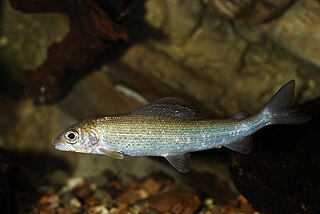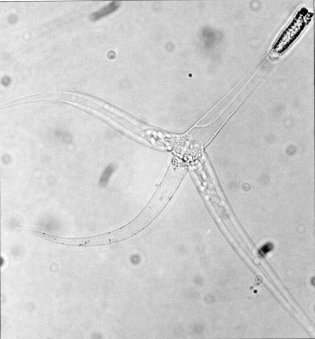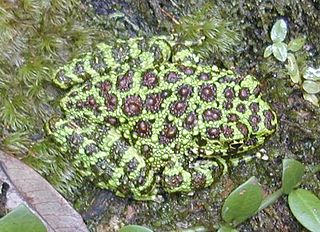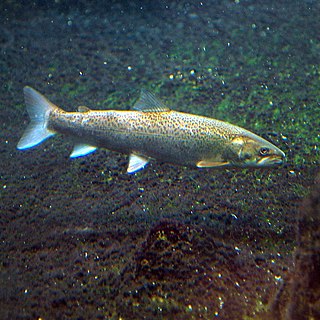
Salmonidae is a family of ray-finned fish that constitutes the only currently extant family in the order Salmoniformes. It includes salmon, trout, chars, freshwater whitefishes, graylings, taimens and lenoks, which are collectively known as the salmonids. The Atlantic salmon, whose Latin name became that of its genus Salmo, is also the eponym of the family and order names.

Herring are forage fish, mostly belonging to the family of Clupeidae.

Thymallus thymallus, the grayling or European grayling, is a species of freshwater fish in the salmon family Salmonidae. It is the only species of the genus Thymallus native to Europe, where it is widespread from the United Kingdom and France to the Ural Mountains in Russia, and Balkans on the south-east, but does not occur in the southern parts of the continent. It was introduced to Morocco in 1948, but it does not appear to have become established there.
Siberian taimen, also known as the common taimen, Siberian giant trout or Siberian salmon, is a species of salmon-like ray-finned fish from the genus Hucho in the family Salmonidae. These fish are found in rivers in Siberia and adjacent regions, and are harvested throughout the year.

The Australian grayling is a primarily freshwater fish found in coastal rivers in south-eastern mainland Australia and Tasmania. In past decades it has also been known as the cucumber mullet or cucumber herring, for its cucumber-like odour.

The Gila trout is a species of salmonid, related to the rainbow trout, native to the Southwest United States. Prior to 2006 the Gila trout was federally listed as endangered. In July 2006, after much work by the Game and Fish departments in New Mexico and Arizona, the US Forest Service and the US Fish and Wildlife Service, the Gila trout was down-listed to threatened, with a special provision called a "4d rule" that will allow limited sport fishing – for the first time in nearly half a century. By the time the Gila trout was closed to fishing in the 1950s, its numbers and range were so depleted and so reduced this copper-colored trout simply wasn't very accessible to anglers. As of 2011 there is fishing in both states for this fish.

The Apache trout or Arizona trout, Oncorhynchus apache, is a species of freshwater fish in the salmon family of order Salmoniformes. It is one of the Pacific trouts.

The huchen, also known as Danube salmon or redfish, is a large species of freshwater fish in the salmon family of order Salmoniformes. It is the type species of its genus Hucho.

Myxobolus cerebralis is a myxosporean parasite of salmonids that causes whirling disease in farmed salmon and trout and also in wild fish populations. It was first described in rainbow trout in Germany in 1893, but its range has spread and it has appeared in most of Europe, the United States, South Africa, Canada and other countries from shipments of cultured and wild fish. In the 1980s, M. cerebralis was found to require a tubificid oligochaete to complete its life cycle. The parasite infects its hosts with its cells after piercing them with polar filaments ejected from nematocyst-like capsules. This infects the cartilage and possibly the nervous tissue of salmonids, causing a potentially lethal infection in which the host develops a black tail, spinal deformities, and possibly more deformities in the anterior part of the fish.

Hucho is a genus of large piscivorous salmonid fish known as taimens, and is closely related to Pacific trout and lenoks. Native to the cold rivers and other freshwater habitats in Eurasia, they are threatened by overfishing and habitat loss.

Ishikawa's frog is a species of frog in the family Ranidae. It is endemic to Okinawa Island, one of the Ryukyu Islands of Japan. It has been described as the most beautiful frog in Japan.

The lake lamprey, Entosphenus macrostomus, also known as the Vancouver lamprey or Cowichan lamprey, a recent derivative of the Pacific lamprey, is a species of freshwater lamprey endemic to two North American lakes: Lake Cowichan and Mesachie Lake in Vancouver Island, Canada. The lamprey was originally called the Vancouver Island lamprey, until an error in filing shortened it to the Vancouver lamprey. The alternate common name of "Cowichan lamprey" was coined and promoted by the species' describer, Dr. Dick Beamish, who originally identified the species in the 1980s.
The iwame trout or markless trout is a variety of salmonid fish inhabiting some fresh waters of Japan. It is an intra-specific mutant morph of the masu salmon that is characterized by a lack of the lateral spot marks typical of the young fish in most populations. The iwame is a stream-resident morph that does not migrate to the sea. It occurs together with the standard phenotype in some populations. This morph is recessively inherited.

Salmo marmoratus, the marble trout, is a species of freshwater fish in the family Salmonidae. It is characterized by a distinctive marbled color pattern and high growth capacity. The marble trout is found in only a handful of drainages and rivers of the Adriatic basin in Italy, Slovenia, Croatia, Bosnia and Herzegovina, and Montenegro, while in Albania, the species is considered most likely extirpated.

The Sakhalin taimen, also known as the Japanese huchen or stringfish, is a large species of salmonid freshwater fish in Northeast Asia, found in the lakes and large rivers of Primorsky, Khabarovsk, Sakhalin and Kuril Islands of Far Eastern Russia, as well as Hokkaido of Japan. Although often placed in the genus Hucho, molecular phylogenetic and other evidence has shown that it belongs in its own monotypic genus Parahucho.

The Sacramento pikeminnow, formerly known as the Sacramento squawfish, is a large cyprinid fish of California, United States. It is native to the Los Angeles River, Sacramento-San Joaquin, Pajaro-Salinas, Russian River, Clear Lake and upper Pit River river basins. It is predatory and reaches up to 1.4 m (4.6 ft) in total length.

Brachymystax lenok, the sharp-snouted lenok, is a salmonid fish distributed in rivers and lakes in northeastern Asia. It formerly included the blunt-snouted lenok, but recent authorities typically treat the latter as a separate species, B. tumensis, based on differences in morphology and genetics.

Krom River or Kromme River is a river in the Eastern Cape Province in South Africa. The river flows into the Indian Ocean through an estuary on the north side of St Francis Bay, west of Port Elizabeth. The Krom river flows in an ESE direction and is approximately 109 km long with a catchment area of 1,085 km2.

Hucho bleekeri, the Sichuan taimen, is a species of freshwater fish in the salmon family (Salmonidae), endemic to the Yangtze basin in China. Their typical habitat includes mountain streams and small rivers, typically being found in the catchment areas of the Dadu River in Sichuan and Qinghai Provinces, as well as the Hanjiang River and its tributaries in southern Shaanxi province. This particular fish population is largely threatened by habitat loss and illegal fishing, resulting in a "critically endangered" conservation status from the International Union for Conservation of Nature.
















